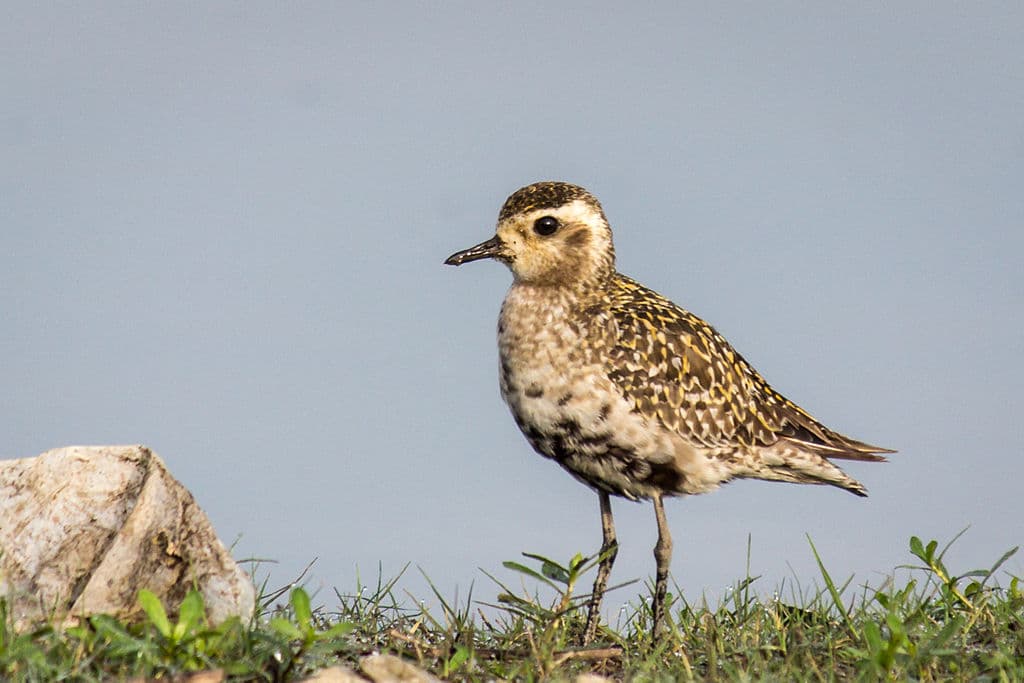So there are 66 plover species in the world, and we have 6 plover species in Cambodia. In our language, we call them “big-headed birds”. There are many things that they associate with in some cultures which is quite interesting as well. However, we are going to focus on the 6 plover species that are residing in Cambodia. Feel free to check them out and see if you have seen any of them before.
Greater Sand Plover (សត្វក្បាលធំវណ្ឌ័ទ្រូងភ្លើងចំពុះវែង)
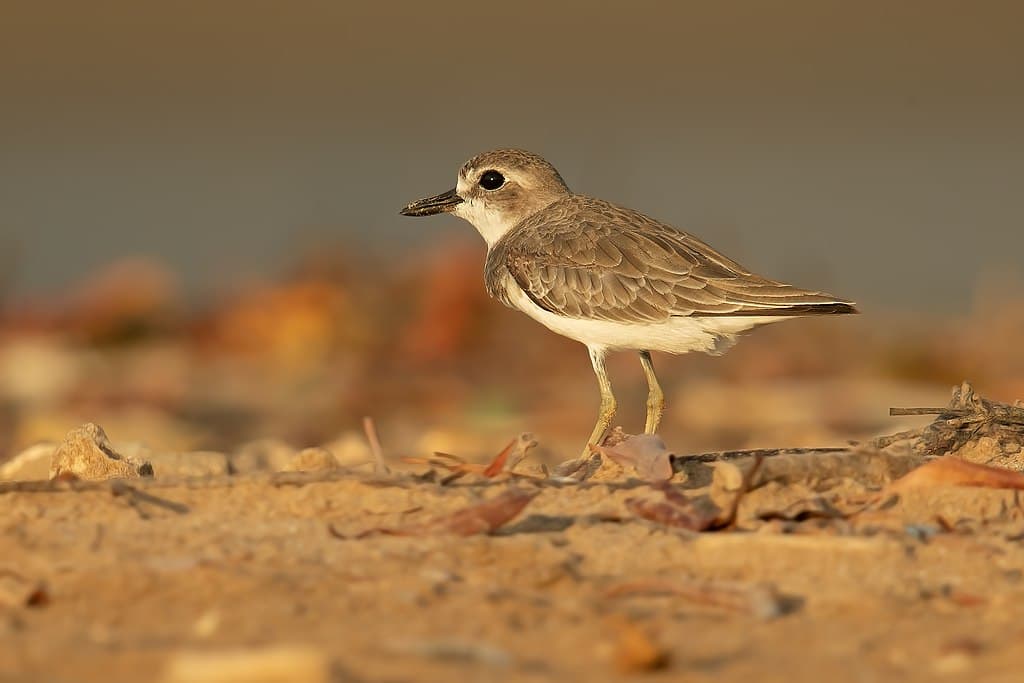
Generally, greater sand plovers have a gray-brown crown, nape, back, and breast patches. Along with that, they have dark lores, bills, and upper wings with dusky ear coverts. As for the legs and feet, they are greenish-gray in color. The greater sand plover has long legs and a thick bill, and males and females have different coloration in the breeding season. Breeding males have gray backs and white underparts, chestnut breast, forehead, and nape with a black eye mask. Meanwhile, the females are duller in color.
The distribution of this plover species is wide across Asia all the way to Australia. They live in estuaries with large intertidal mudflats or sandbanks, muddy beaches, shelly beaches, and sheltered sandy areas. Greater sand plovers roost during high tide and begin foraging on wet ground at low tide. Their common food consists of annelid worms, crustaceans, and insects that they catch by their run-and-pause technique. The technique simply involves them running a short distance, stopping to look, and then running to collect the prey.
Gray Plover (សត្វក្បាលធំប្រផេះ)
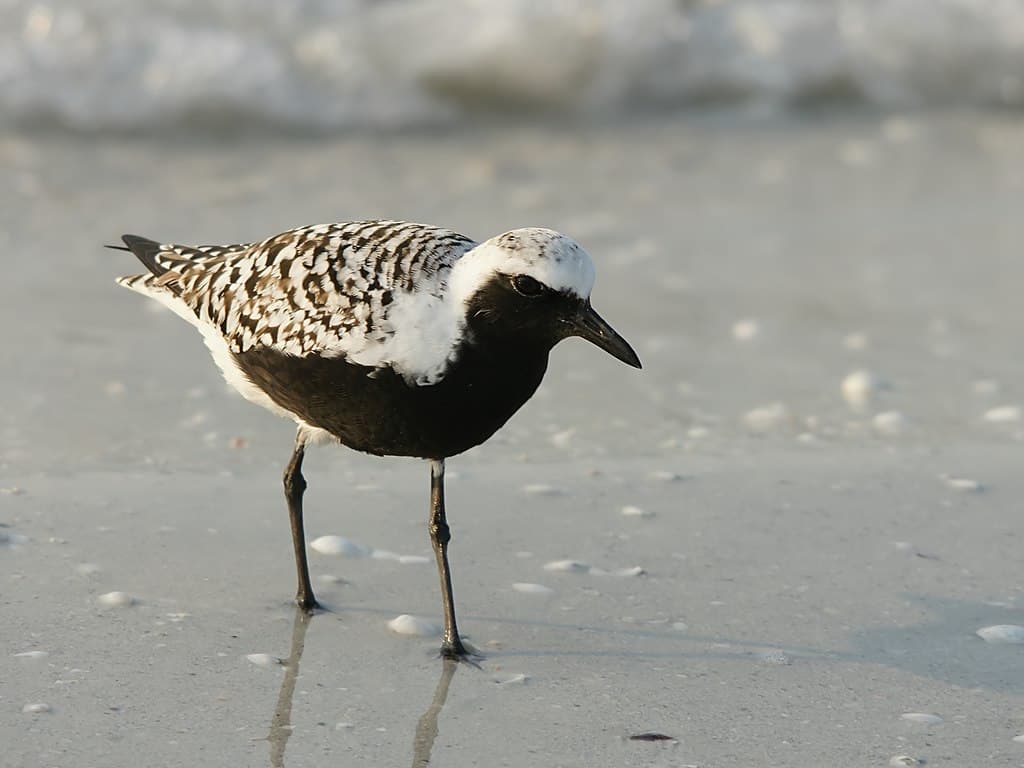
In North America, they are known as the black-bellied plover due to the black belly and breast. These birds are around 27 to 30 centimeters long, and adults are spotted black and white on the back and wings. Their faces and neck are also black with a white border, and the tail is white with black barring. The body of a gray plover is large and sturdy, and it has a round head and short neck. As for the bill, it is short and thick while the wings are pointy and the tail is slightly rounded.
The gray plovers are very shy, and they startle easily even at the slightest disturbance or threat. They will fly away, circle, and return to rest or continue feeding when they feel that the threat is gone. At the same time, they are also quick to give alarm calls which is a series of high and clear whistles of three notes.
Gray plovers are one of the most interesting plover species due to their behaviors and habits. These plovers are large cosmopolitan species that breed in the Arctic regions. Gray plovers nest on the ground in a dry open tundra with good visibility, and females usually lay 4 eggs. Along with that, they are also long-distance migrants that have a nearly worldwide coastal distribution when not breeding. Across their habitats, they forage for food on beaches and tidal flats by standing and watching before running forward and pecking. The diet of these plovers consists of crustaceans, insects, polychaete worms, and small mollusks.
Kentish Plover (សត្វក្បាលធំជើងខ្មៅ)
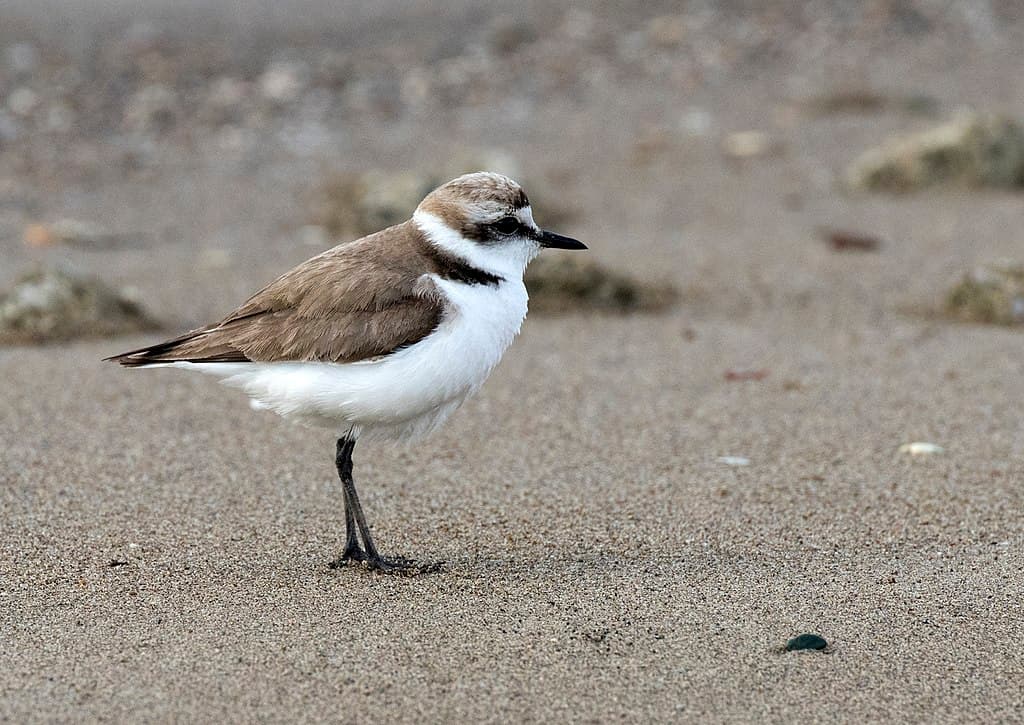
By the look, you can already tell that this plover species is quite small. A Kentish plover grows to only around 15 centimeters to 17.5 centimeters long. Breeding males have a black horizontal head bar, two incomplete dark breast bands on each side, and black ear coverts. As for their crown and nape, they are rufous in color. Meanwhile, breeding females are paler in color and they lack dark markings.
Kentish plovers either forage individually or in loose flocks of 20-30 individuals, or even in larger flocks of up to 260 individuals. Within their flocks, they feed on both miniature aquatic and terrestrial invertebrates such as insects and their larvae. At the same time, they also consume crustaceans, marine worms, mollusks, and spiders.
Compared to other plover species, this one has an extremely wide geographical distribution across the globe. Their range is across Africa, Asia, and Europe, and their habitats are also quite varied. Generally, they prefer coastal locations so these birds are very common on dry mudflats, salt ponds, and sandy beaches. When it comes to the breeding season, they like to nest in areas with sparse vegetation that is close to water.
Sadly, Kentish plovers are facing threats by habitat disturbance and habitat loss. Along with that, pollution, urbanization, and unsustainable harvesting also play a role in destroying their nesting sites. Not to mention egg collection by fishermen, their population is not doing well so all.
Little Ringed Plover (សត្វក្បាលធំវ័ណ្ឌទ្រូងខ្មៅ)
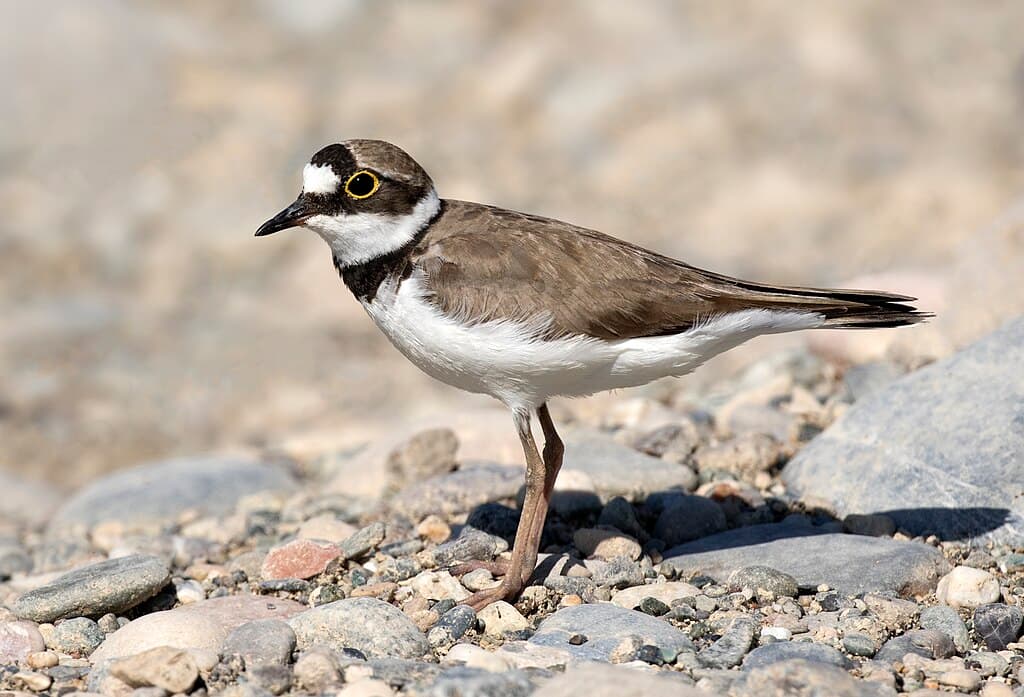
Looks very similar to the previous plover species, this one is actually a different one. You can tell by the head pattern, leg color, and the presence of a clear yellow eye ring. As for the size, it grows to only around 14 to 15 centimeters long. A little ringed plover has a gray-brown back and wings, a white belly, and a white breast with one black neckband. It has a brown cap, a white forehead, a black mask around its eyes with white above, and its short bill is dark. As for the legs, they are fleshy colored while the toes are all webbed.
The distribution of these plovers is across various areas, especially in Asia and Europe. Their habitats are in coastal regions, flooded meadows, freshwater areas, shingle banks, and wetlands. Where they live, they forage for crustaceans and invertebrates by standing and watching before running forward and pecking. Their most common food are ants, earthworms, flies, insects, and invertebrates that they can find. Besides their usual habits, little ringed plovers are quite aggressive and territorial to those to threaten their nest sites.
Malaysian Plover (សត្វក្បាលធំខ្សាច់)
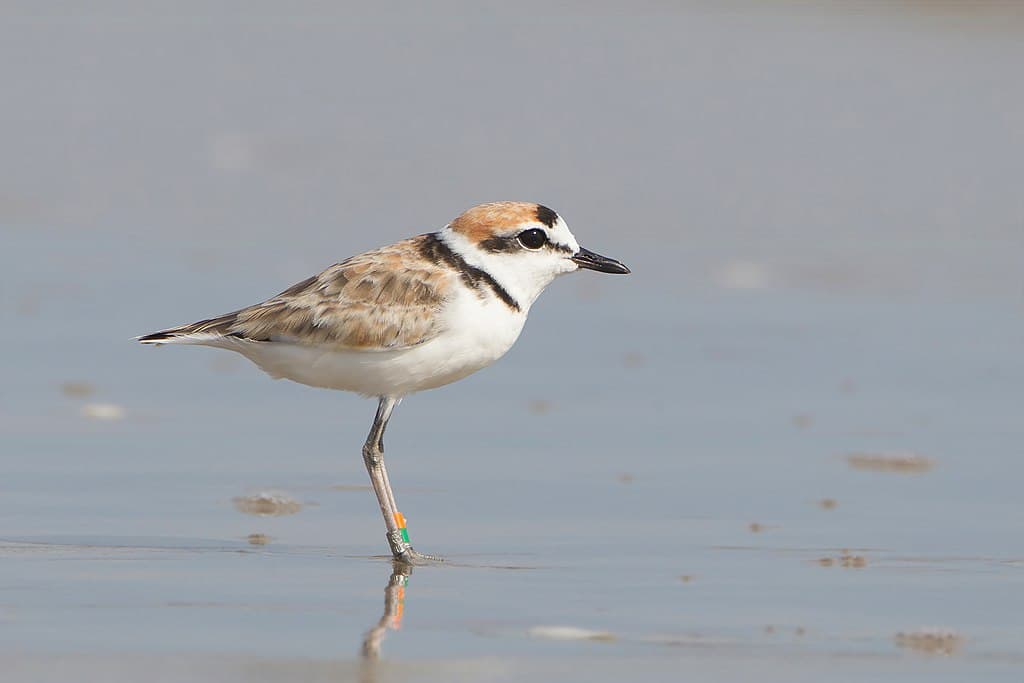
Having a similar size to the little ringed plovers, the Malaysian plovers grow to only around 15 centimeters long. You can distinguish males by a thin black band around their neck as females have a thin brown band instead. Both sexes have white underparts and light brown upperparts with pale legs. As wading birds, they are very common near bodies of water. It is not unlikely to see them doing their hunting dance on beaches and sandy strands. The dance consists of a distinctive series of runs, pauses, pecks, and shuffles that they use to startle their small prey.
Their habitats include coastlines, estuaries, inland lakes, ponds, and watery habitats. At the same time, they are also found in arctic, near arctic, subtropical, temperate, and tropical zones throughout the world as well. The prey of these little birds are beetles, flies, and insects along with crustaceans and marine worms depending on where they hunt. Sometimes they also consume plant stems and seeds if carnivorous meals are not available. The sad thing is that this plover species is now considered Near Threatened on the IUCN Red List. Their population decline is due to human disturbance and infrastructure development that affect their habitats and nesting sites.
Pacific Golden Plover (សត្វក្បាលធំពណ៌មាស)
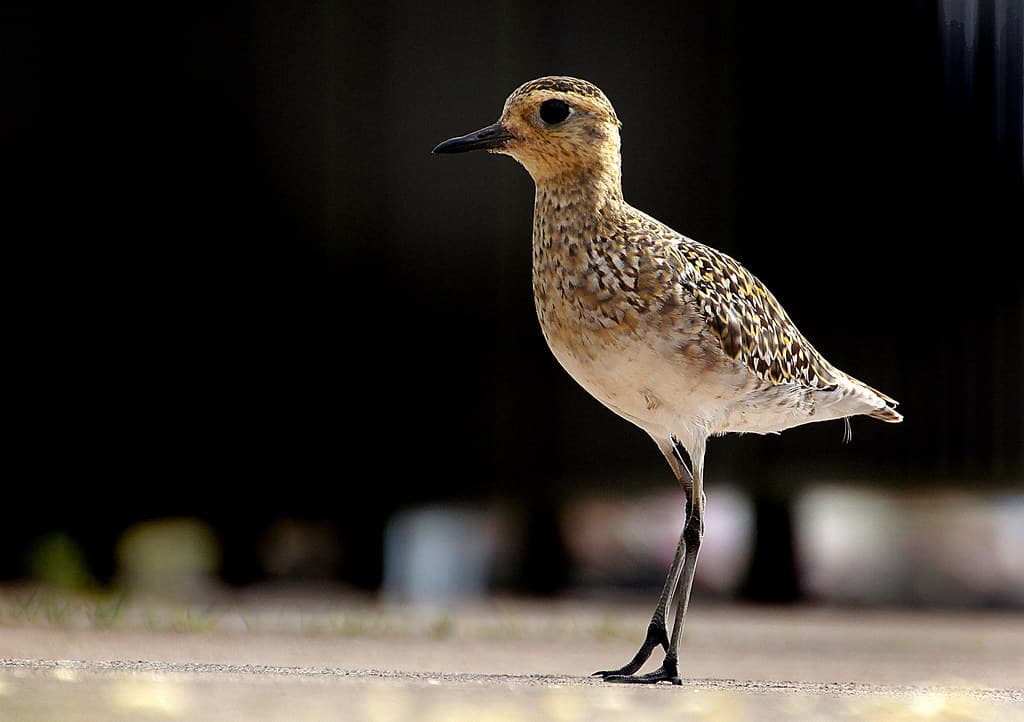
The Pacific golden plover is a large shorebird that grows up to 25 centimeters long with a wingspan of 61 centimeters. Both males and females have light underparts with dark brown, gray, and yellowish patterns, and black breast, face, and neck. The rump is dark, and the legs and bills are black. During the breeding season in March and April, males will have gold and black spots on their crown, back, and wings.
When it comes to distribution, their population spreads across Australia, India, Southeast Asia, and the Arctic tundra. This plover species live in coastal golf course, estuaries, lagoons, rocky and sandy wetlands, and salt marsh. Normally, they forage on beaches, mowed grass, tidal flats, and tundra where they look for crustaceans, insects, mollusks, and spiders. Sometimes they also feed on small reptiles as well as berries, leaves, and seeds.
Related Post: Lapwing Species In Cambodia
